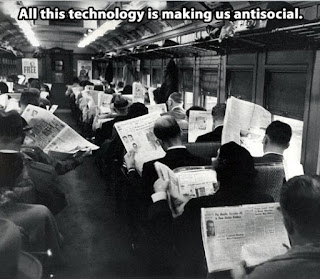YouTube comedy group SCRIMSHANKRECORDS (nicknamed SSR) created a parody video combining Trekkie stereotypes and quotes with the LMFAO song, "I'm sexy and I know it." This enterprise (pun intended) that SSR undertook combines an overanalyzing fandom with an obviously tongue-in-cheek song. It seems to reward knowledgeable fans of the Star Trek show, with tons of clever lines and Easter Eggs. But it also manages to entertain the average audience member who may not know much of anything about Star Trek.
"We Trekkies and we know it"
"Weeeee are Trekkieeeeeeeees!!"
(in front of the Riverside, Iowa sign, future birthplace of James Kirk)
SCRIMSHANKRECORDS, the creators of the parody video, seem to be major Star Trek fans, also called Trekkies. According to their Facebook page, the three men who create the parody videos go by user names: Werd-dreW, LocoBradito, and Ushmasta. They each have joking bios about their lives and it also seems that their channel is now dead, having not released any new content since 2013. Apparently they live up to the definition of their YouTube name: Scrimshank means "that which one does whilst procrastinating." This could refer to the viewer choosing to watch the video instead of something more productive or it could be a light jab at their own release schedule, which is apparently not very consistent anymore.
Regardless, I think it is obvious that SSR are major Trekkies, members of the almost fanatical fandom that follow the voyages of the star-ship Enterprise (and all the other various space ships that the show follows). The video is full of famous Star Trek quotes and lines. For instance, perhaps the most famous hand signal in all geek fandom, the Vulcan salute, makes a prominent appearance in verse two. SSR name drops common Star Trek terms like "Enterprise," "Beam me up Scotty," "Captain Kirk out," and many others. Visual trivia, such as SSR dancing in front of the sign to Riverside Iowa, the future birthplace of Captain Kirk reward Trekkies for knowing random facts. The parody is clever though because it is accessible to both loyal fans of the show and the laymen watcher.
Trekkies are not exactly a welcoming group to the un-knowledgeable. The biggest fans of the show know far too much about it, from character names to the complex layout of the ship. They start brutal arguments with other fans over topics like, "Who is the better Captain: Kirk or Picard?" Trekkies will fight tooth and nail to declare that their opinion is right and their opponent is wrong. This is comparable to every other fandom but few take it to as far of an extreme. However this parody video appears to appease both fans and non fans alike.
For example, the main refrain of the song is backed up by the popular line "Khaaaan!" from Captain Kirk himself. To a fan who knows who William Shatner is and knows of his legendary "over acting" in almost every scene, this vocal track is funny because it brings the over the top line into an over the top parody. But it also works on basic level for the un-informed. Viewers who don't know anything about William Shatner can enjoy the weird face he is making and super loud way he says the line. Removed from the dramatic context where the line is actually said, it looks and sounds fairly ridiculous, perfect for a goofy parody video.
The overall feel of the video works for both Trekkies and non fans. Both groups can collectively mock the "I'm sexy and I know it" song and they can especially laugh at the nerdy dancing that all three members of SSR use. With all the pelvic thrusting and lame swaying back and forth, its clear that they are trying to combine the "sexiness" of the LMFAO video and the nerdiness of Star Trek. Fans can enjoy seeing men in the supposed-to-be-taken-seriously uniforms of Star Fleet dancing like weirdos and non fans can just laugh at the annoying singing and dancing.
In conclusion, YouTube artists have to be mindful of their audience when creating content. Parody videos can be very funny if done correctly but fans can also take major offense if the creator is not careful. SSR have a large amount of courage for making a goofy video that pokes fun at such a volatile and strong fandom. But I think Trekkies are quite used to having people make fun of them. Movies like "Galaxy Quest," both make fun of and treasure fans of Star Trek and they seem to have a higher tolerance for mocking than usual. I took a look in the comments section of the video and this comment had 6 thumbs up:"Its's great to see Trekkies standing proud, if only it was cool when I was at school I had my a$$ handed to me for being a Trekkie at school." I think it's great that our culture has progressed enough for nerds to be proud of their favorite shows and movies in public.
Sources:
Original Video
https://www.youtube.com/watch?v=SNfYz6Yw0W8&list=PLreodM-Supw8qjOOBGZSF87iUmVMgFVow&index=6
SSR YouTube Page
https://www.youtube.com/user/SCRIMSHANKRECORDS/about
SSR Facebook Page
https://www.facebook.com/Scrimshank-Records-153327661463950/info?tab=page_info
Urban Dictionary Definition of "Scrimshanker"
http://www.urbandictionary.com/define.php?term=scrimshanker












